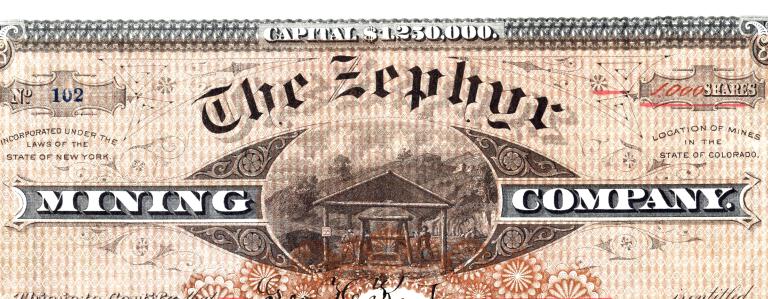Beautifully engraved certificate issued to G. H. Kent from The Zephyr Mining Company issued in 1881. This historic document was printed by the American Banknote Company and has an ornate border around it with an image of an old mining scene. Nice looking certificate with copper luster ink used in the underprinting. This item has the signatures of the Company's V. President and Secretary, and is over 132 years old. Punched cancelled. Original stock ledger page attached on left side with G. H. Kent signature. 
Certificate Image The Monarch Mining District, between Salida and Gunnison, on the east side of Monarch Pass, produced about $10 million of silver, gold, lead and copper between 1878 and 1910. Taylor Gulch, the 1000' deep gulch that divides Taylor Mountain and Missouri Hill, was the location of the most productive mines in the area. The Zephyr Mining Company properties were located in Taylor Gulch 6 miles northwest of Marysville. Mines in the 1880's included the Zephyr, Bonnie Bell and Ben Hill, all in Taylor Gulch. Veins were 4 to 8 feet in width, and produced 1 ounce of gold per ton and 40 ounces of silver per ton. Mining at the higher altitudes, up to 12,000' elevation, was limited to the late months of summer. Today there are working limestone quarries in Taylor Gulch just above the town of Garfield. The first ore shipped from the Monarch District came in wagon shipments to Canon City. They averaged 200 ounces of silver per ton. But most development occurred after the railroad was laid from Poncha Springs to Maysville, most of the way up the pass to the Monarch district. The complex geology of Taylor Gulch came from folding and faulting of very diverse strata. The softer exposed sedimetary rock eroded to a deep gulch, exposing large areas of the surrounding strata. Productive mines were located in both limestone and monzonite quartz zones. History from Encyberpedia and OldCompany.com (old stock certificate research service)

Certificate Image










